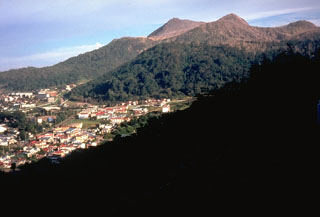Report on Toya (Japan) — June 1978
Scientific Event Alert Network Bulletin, vol. 3, no. 6 (June 1978)
Managing Editor: David Squires.
Toya (Japan) Seven new steam explosions, causing minor ashfalls
Please cite this report as:
Global Volcanism Program, 1978. Report on Toya (Japan) (Squires, D., ed.). Scientific Event Alert Network Bulletin, 3:6. Smithsonian Institution. https://doi.org/10.5479/si.GVP.SEAN197806-285030
Toya
Japan
42.544°N, 140.839°E; summit elev. 733 m
All times are local (unless otherwise noted)
After 30 days of quiescence, steam explosions occurred on 26, 29, and 31 May, and 1, 2, 4, and 7 June, causing ashfalls on surrounding villages. The largest explosion produced a 3-mm ash deposit in a village at the foot of the volcano, and blocks were scattered in the summit crater, 500 m from the vent. Scientists from the University of Hokkaido observed the ejection of incandescent blocks during the night of 2 June, the first incandescent ejecta recognized since the initial large [pumice eruptions] of August 1977. This suggests that the rising magma column is now near the surface.
. . . The general downtrend in daily seismicity that began in February continued through early June. The rate of uplift at the new cryptodome (centered about 400 km E of the summit of Ko-Usu) increased sharply in February, but began to decrease in March and continued to decrease through May (data from I. Yokoyama).
Geological Summary. Usuzan, one of Hokkaido's most well-known volcanoes, is a small stratovolcano located astride the southern topographic rim of the 110,000-year-old Toya caldera. The center of the 10-km-wide, lake-filled caldera contains Nakajima, a group of forested Pleistocene andesitic lava domes. The summit of the basaltic-to-andesitic edifice of Usu is cut by a somma formed about 20-30,000 years ago when collapse of the volcano produced a debris avalanche that reached the sea. Dacitic domes erupted along two NW-SE-trending lines fill and flank the summit caldera. Three of these domes, O-Usu, Ko-Usu and Showashinzan, along with seven crypto-domes, were erupted during historical time. The 1663 eruption of Usu was one of the largest in Hokkaido during historical time. The war-time growth of Showashinzan from 1943-45 was painstakingly documented by the local postmaster, who created the first detailed record of growth of a lava dome.
Information Contacts: JMA, Tokyo.

